My Proven 7-Step Fashion Brand Messaging Framework: How To Increase Sales With Strategic Language

In today’s fashion world, there’s more competition than ever, but that doesn’t mean there’s no room for your brand. The key? Messaging that grabs attention, builds emotional connections, and sets you apart. Magnetic messaging can turn casual browsers into loyal fans, and today, I’m going to show you how.
After building two clothing brands from the ground up, I know firsthand how critical it is to speak to your audience in a way that resonates with their deepest needs and desires. It’s not just about selling clothes – it’s about selling a feeling, a lifestyle, and a transformation.
My 7 Step Fashion Brand Messaging Framework
- Step 1: Understand Your Audience’s Emotions
- Step 2: Speak to Their Needs with Solutions-Oriented Language
- Step 3: Use Empowering, Aspirational Language
- Step 4: Create a Clear, Consistent Brand Voice
- Step 5: Harness the Power of Storytelling
- Step 6: Build Emotional Connections with Visuals and Language
- Step 7: Repurpose Messaging for Efficiency and Impact
Let’s dive into the steps for creating magnetic messaging that will make your clothing brand unforgettable!
Step 1: Know Your Audience
The first step to creating magnetic messaging is knowing your audience and understanding their emotions. Not only will this help with your brand’s messaging (which leads to more sales!), but also with your ability to connect deeply to your ideal customer. Check out this post to learn how to define your ideal customer in 5 easy steps.
Ask yourself:
- What do they crave when it comes to fashion?
- What are their biggest pain points?
- What language or slang do they use to describe their situation?
- Where can you go online to learn more about your ideal customer?
Once you’ve got some great answers to the questions above, you need to intentionally weave that information all throughout your clothing brand’s messaging.
An example from my own brand, Persnickety:
- Customer’s pain point: “I don’t have time to hunt for the perfect outfit.”
- Messaging example: “Your time is precious – we get it. That’s why we’ve curated effortless collections that take the guesswork out of dressing for life’s big moments. Shop with confidence, knowing you’ll find something special, every time.”
Step 2: Speak to Their Needs with Solutions-Oriented Language
Your messaging needs to be more than just a description of your clothing – it needs to address specific pain points your audience faces. Do they struggle to find clothes that fit both their style and their lifestyle? Do they want pieces that are timeless, not trendy? Or maybe they want to invest in quality, but aren’t sure what to look for.
By offering clear solutions to these problems, you’re not just selling clothing – you’re positioning your brand as a trusted guide in their fashion journey.
For example, if your pieces are designed to last, emphasize that they are investments, not fast fashion. Help your customers envision themselves wearing these pieces for years to come, saving them time and money in the long run.
This type of solutions-oriented messaging creates a sense of trust and loyalty because you’re helping your audience solve real problems.
An example from my own brand, Persnickety:
- Customer’s pain point: “I need something that’s high-quality and will last.”
- Messaging example: “Special occasions deserve outfits that stand the test of time. Our premium fabrics and meticulous creations mean you’re investing in more than a look – you’re creating heirloom pieces for your family’s most cherished memories.”

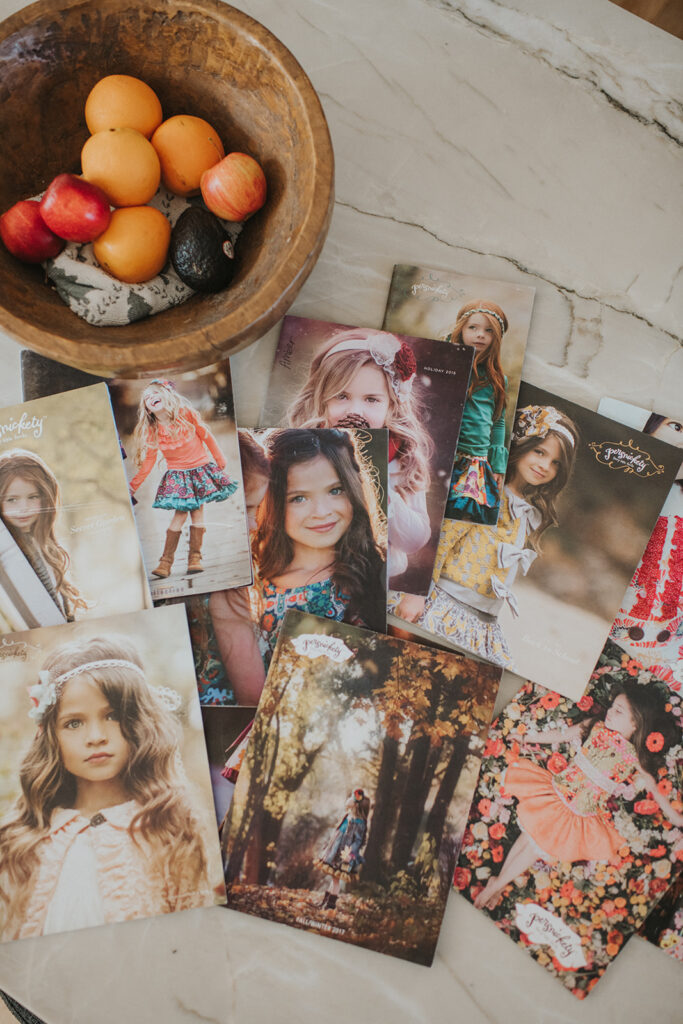
Step 3: Use Empowering, Aspirational Language
Your customers want to feel like their clothing is a reflection of their best selves. That’s why it’s crucial to use language that empowers them. Highlight the qualities your clothing embodies – strength, femininity, elegance, confidence – and tie them to the aspirations of your audience.
For example, you might say something like, “Our collection is designed for women who want to feel both strong and feminine, effortlessly blending sophistication, elegance and comfort.” This not only speaks to the product but also to the identity your customer wants to embody.
Empowering language makes your customers feel seen, understood, and excited, which is key to creating emotional connections with your brand.
An example from my own brand, Persnickety:
- Customer’s pain point: “I want my daughter to feel confident and beautiful.”
- Messaging example: “When she feels confident, it shows. Our designs are made to make her feel as special as the moments she’s dressing for – with soft, lasting fabrics, vibrant colors and patterns, and enchanting details that let her shine.”
Step 4: Create a Clear, Consistent Brand Voice
A key step in this fashion brand messaging framework is having a consistent brand voice. Consistency is everything when it comes to building trust with your audience. Your brand voice should be clear and aligned with your core values – whether that’s elegance, sustainability, or affordability. When people hear your messaging, they should immediately know it’s you.
To keep things consistent, I highly recommend developing a brand messaging guide that outlines your tone, key phrases, and core messages. This will ensure that whether you’re writing a social media post, an email, or a product description, your brand voice remains strong and unified.
Not to mention, when you expand your brand someday and hire employees, you’ll want them all to be on the same page as you with messaging. A brand messaging guide will easily show them which language / tone to use in their writing.
An example from my own brand, Persnickety:
- Customer’s pain point: “It’s impossible to find unique outfits that feel special and stand out.”
- Messaging example: “Looking for something truly unforgettable? Our designs are crafted to turn heads and create magical moments. Every piece is a one-of-a-kind blend of elegance and whimsy, perfect for the occasions you’ll cherish forever.”
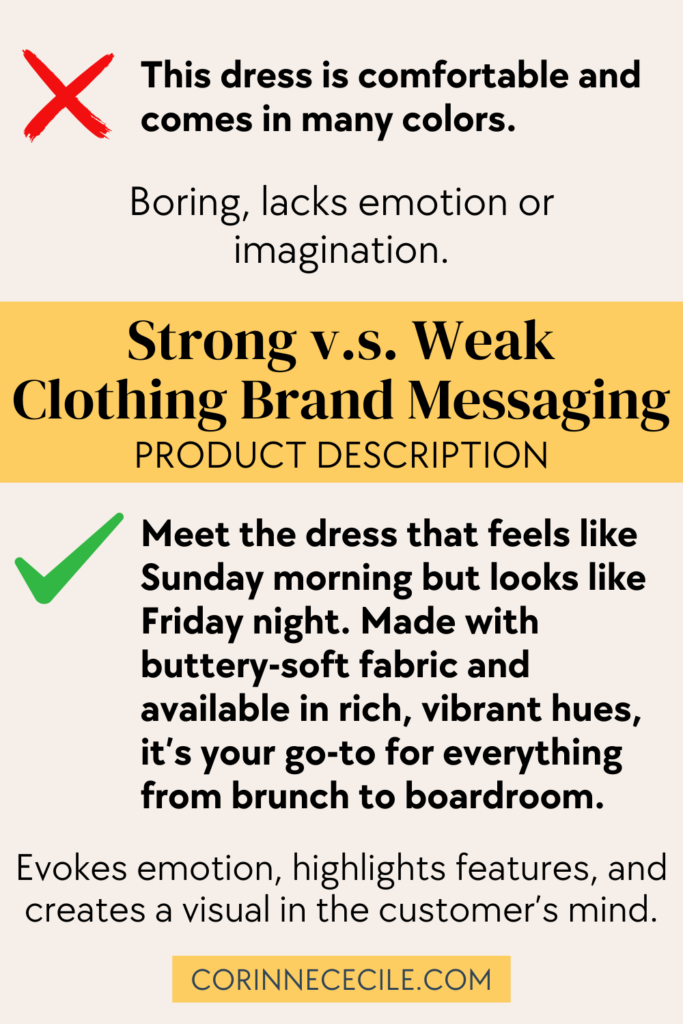
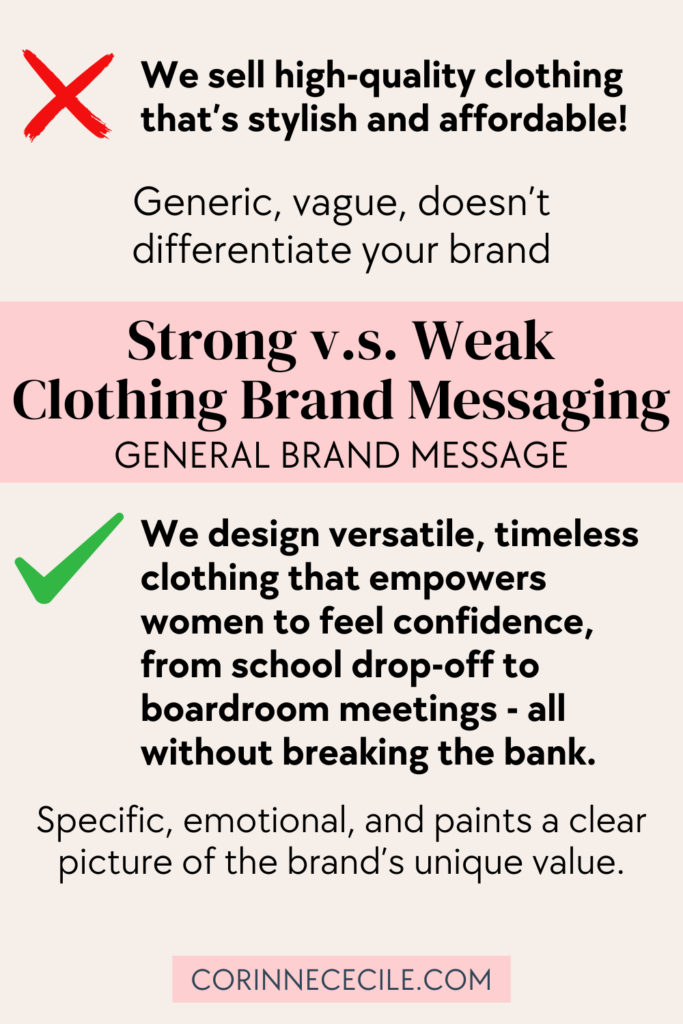
Step 5: Harness the Power of Storytelling
People love stories. Telling your brand story can be one of the most powerful tools in your messaging arsenal. Whether it’s the story of how you got started or a behind-the-scenes look at how your products are made, storytelling makes your brand more relatable and engaging.
For example, sharing how you began designing clothes from your kitchen table while juggling a full-time job and motherhood can resonate with women who are also trying to balance multiple responsibilities. These stories build a connection beyond just the product and make your audience feel like they’re part of something bigger.
Step 6: Build Emotional Connections with Visuals and Language
Your visuals and language need to work hand in hand. The imagery you use should evoke the same emotions your words do. If your messaging is all about timeless elegance, your visuals should reflect that with clean, sophisticated imagery.
Think about how you can use visuals to enhance your message. Maybe it’s a customer wearing your piece in a beautiful setting, or a behind-the-scenes look at your design process. Make sure every image tells a story and reinforces the emotional connection you’re building through your words.
An example from my own brand, Persnickety:
- Customer’s pain point: “I want my family pictures to look perfect, but finding the right outfit is so stressful!”
- Messaging example: “Say goodbye to mismatched chaos and hello to picture-perfect moments. Our timeless designs make your family photos as stunning as your memories. From rich texture to unique details, our pieces take the stress out of planning and put the joy back into your special day.”
Step 7: Repurpose Messaging for Efficiency and Impact
Creating magnetic messaging doesn’t mean starting from scratch every time. Once you have messaging that works, repurpose it! Create a cheat sheet of key phrases and emotional triggers that you can use across your social media, email campaigns, and website.
If you’ve written a great social post, don’t be afraid to turn it into a blog or use the same messaging in an email campaign. Repurposing content is not only efficient, but it also helps to reinforce your brand message. Consistency builds recognition, and recognition leads to trust – and ultimately, loyal customers!
Key Point To Remember
Magnetic messaging is the heartbeat of a successful clothing brand. It’s what transforms casual shoppers into lifelong fans and helps your brand rise above the noise. By understanding your audience’s emotions, speaking to their needs, and using empowering language, you can craft messaging that not only sells, but resonates deeply.
How To Use This Fashion Brand Messaging Framework
If you’re a new fashion designer looking to launch your first clothing brand, I invite you to check out all of the ways I can support you. After creating and scaling two successful clothing brands, I now passionately teach women like you how to do the same.
If you need step-by-step support on your journey, check out my mentorship program, Fruition. You’ll find answers to every single question you could have, because I’ve been through it all.
And if you’re already a successful clothing brand owner, I challenge you to revisit your fashion brand messaging framework and ask yourself if you can implement even a little bit more from this guide. Check out the posts below for more resources!
*Messaging examples taken from my own brand, Persnickety Clothing
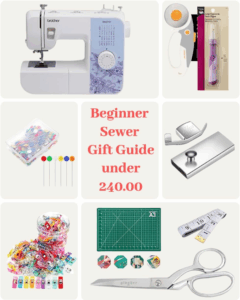


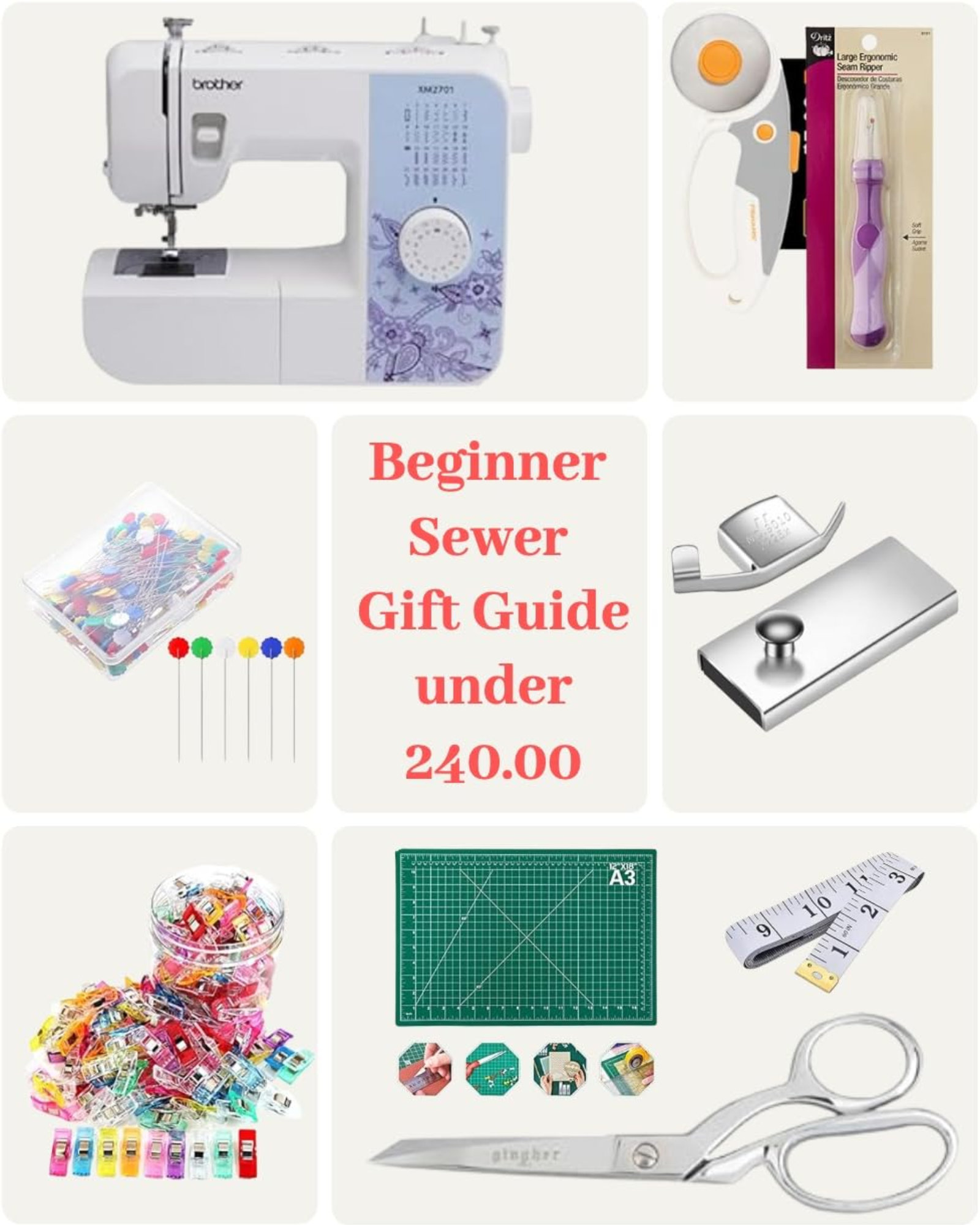



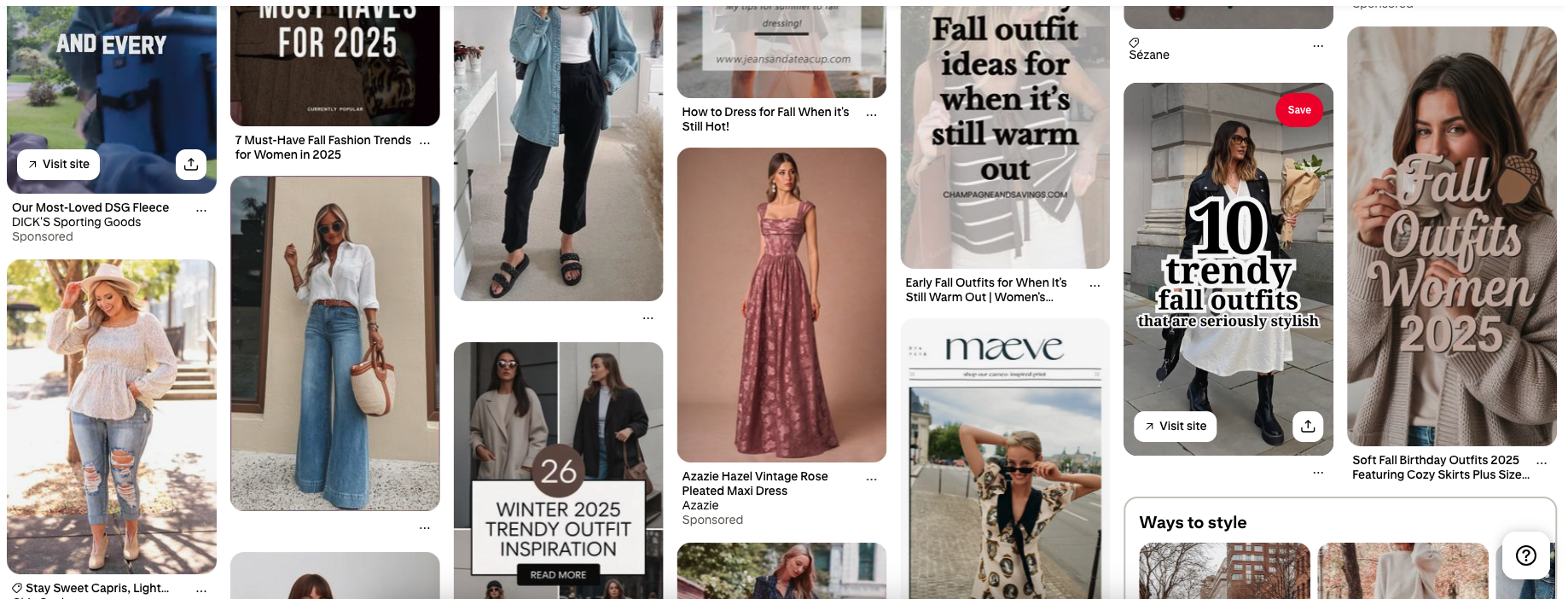
Read the Comments +